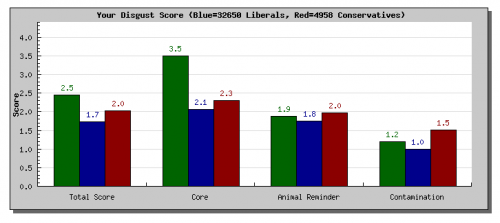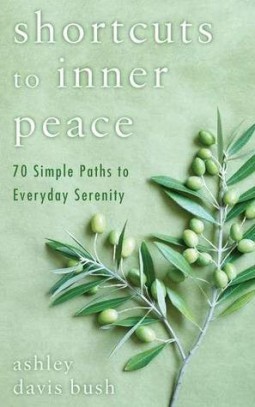Bodhipaksa's Blog, page 80
January 24, 2012
How prone are you to disgust? There's a very interesting article in the New York Times about stud…

How prone are you to disgust?
There's a very interesting article in the New York Times about studies on the emotion of disgust (http://nyti.ms/zcqt1w) as well as a link to a survey set up by Jonathan Haidt. The survey (http://bit.ly/youNKH) was fascinating.
Apparently I rate very highly for core disgust, which is protecting the mouth from contamination. It's true. I feel nauseous very easily. I'm like an average conservative (conservatives are more prone to disgust) when it comes to reminders of my animal nature, and also regarding contamination (protecting the body generally from disease and uncleanness). I was quite surprised to learn this.
They have a bunch of other surveys you can take as well. I've signed up.
January 23, 2012
A major victory over the encroaching surveillance state
Can you have faith, but disbelieve the Buddha?
 Facebook's a funny place. You'll post a link to a really brilliant, informative, insightful, and useful article on meditation and get very little response, and then post a picture of a dog meditating and get swamped with "likes" and comments. An example of the latter happened recently when I idly shared this cartoon on reincarnation. (It's from speedbump.com — go visit the site, and consider buying a cartoon.)
Facebook's a funny place. You'll post a link to a really brilliant, informative, insightful, and useful article on meditation and get very little response, and then post a picture of a dog meditating and get swamped with "likes" and comments. An example of the latter happened recently when I idly shared this cartoon on reincarnation. (It's from speedbump.com — go visit the site, and consider buying a cartoon.)
Of course someone asked me what my own view on rebirth was, and I replied to the effect that on balance I'm not a believer. I made clear it's not that I deny the possibility of rebirth — it just seems vanishingly unlikely that any kind of consciousness can exist outside of a brain, or be transferred from one brain to another. I guess you could say I'm an agnostic, and a skeptical one at that.
But this admission suddenly created a discussion in which it was suggested that I was lacking and downplaying faith, and had "modern rationalist prejudice" against the idea of rebirth.
I don't really want to write too much about rebirth here — I'll save that for another post — but I would like to say something about the nature of faith (saddha in Pali, or shraddha in Sanskrit) in Buddhism, and how having it doesn't mean that you have to believe everything the Buddha said.
I'd also like to point out that saddha (faith) has very little to do, in the Buddhist tradition, with belief in things that you can't verify in your experience.
Early Buddhist texts tell us that when you attain the first level of spiritual awakening (stream entry) you have have unshakable faith in three things: the Buddha, his teaching (the Dhamma), and the spiritual community (the Sangha). But it's important to examine how each of these things is described.
First, faith in the Buddha.
The disciple of the noble ones is endowed with verified confidence in the Awakened One: 'Indeed, the Blessed One is worthy and rightly self-awakened, consummate in knowledge & conduct, well-gone, an expert with regard to the world, unexcelled as a trainer for those people fit to be tamed, the Teacher of divine & human beings, awakened, blessed.'
The faith being advocated here is confidence that the Buddha is a realized teacher: that he has attained spiritual awakening and that he's able to guide us to that same awakening.
Now, we can't directly verify for ourselves that the Buddha was awakened. But we can read his words, and see the effects of Buddhist practice in others, and in our own lives, and on that basis develop confidence that there was something special about him — that he had some extraordinary insight. And we can have confidence that his teaching, in principle, can led to us having the same insight. This isn't blind faith. It's faith rooted in experience.
Second, faith in the Dhamma (teachings, path):
He is endowed with verified confidence in the Dhamma: 'The Dhamma is well-expounded by the Blessed One, to be seen here & now, timeless, inviting verification, pertinent, to be realized by the wise for themselves.'
I'm not going to parse this entire passage, but here, faith is confidence that the Buddha's teaching is something that can be verified ("inviting verification … to be seen here and now … to be realized").
The core of this confidence is recognition of the Dhamma as a verifiable process. We can't — and this is important — verify the Dharma in its entirety right now. It has to be verified in our experience, and that takes time. Again, there's no blind faith involved.
Third, faith in the Sangha, or spiritual community:
He is endowed with verified confidence in the Sangha: 'The Sangha of the Blessed One's disciples who have practiced well…who have practiced straight-forwardly…who have practiced methodically…who have practiced masterfully — [the various types of awakened individuals] — they are the Sangha of the Blessed One's disciples: worthy of gifts, worthy of hospitality, worthy of offerings, worthy of respect, the incomparable field of merit for the world.'
This seems a straightforward kind of confidence: confidence that it's a good thing to master the teachings and become spiritually awakened, that it's a good thing to respect and honor people who have done so. This is an aspirational attitude, and also a devotional attitude, which is very important in Buddhist practice. It's why you'll see Buddhists bowing in front of Buddha statues (and to each other!). We need to respect and honor goodness and wisdom when we see it. But again, there's no blind faith involved.
So this is the kind of faith that someone who is a stream entrant has, that someone who has reached the first level of awakening has. These types of faith are called "factors of stream entry" and they're not only seen as characteristics of the stream entrant, but as means to gain stream entry itself. It has very little — nothing, really — to do with belief in things that you can't verify in your experience. It's all "provisional trust" in something that you intend to, and can, verify.
I'd like to come back and talk a little about the teaching of rebirth. The scriptures are full of references to rebirth and to afterlives in heaven or hell. Although some have argued that the Buddha only taught rebirth as an accommodation to the culture he lived in, I see that in itself as a leap of faith! We know something of what the Buddha said, but we can never know what he was thinking if it was different from what he is recorded as having said. It seems reasonable to accept that the Buddha believed in rebirth.
Does that mean that I should, out of faith, believe in rebirth? I don't think it does. For one thing, I can't verify the existence of rebirth in my own experience. I don't remember any previous lives, and there are always going to be questions hovering over the accounts of people who say they do. I can't 100% verify their accounts. In fact I can't verify their accounts at all, since all I've ever had to go on are other people's accounts of their accounts.
For another thing, the Buddha said other things that we know to be incorrect — or at least he's recorded as having said those things. There is no mountain hundreds of thousands of miles high, around which four continents are arranged. Those continents do not float on water, which in turn does not rest on air. Earthquakes therefore are not caused by the air which lies under the water which lies under the continents.
The Buddha's area of expertise was spiritual psychology. Evidently, he didn't know any more about geography, geology, and cosmology than any other educated Indian of his time. Although I recognize the Buddha as a sure guide to overcoming greed, hatred, and spiritual delusion, I've no reason to believe that he had any special insight into what happens after death.
Most importantly, though, it makes no difference to my practice to be skeptical of the reality of rebirth. I'm going to make the most of this life, whether or not I'll be reborn. In fact, I'd argue that thinking it's probable that this is the only life I'll have gives me more of a sense of urgency about practicing. In fact the Buddha's recorded as saying that his disciples can have the assurance that "if there is no fruit [in future lives] of actions rightly & wrongly done, then here in the present life I look after myself with ease — free from hostility, free from ill will, free from trouble."
If that was good enough for the Buddha, then that's good enough for me.
January 22, 2012
How to love yourself (guardian angel not supplied)
Someone on Facebook just introduced me to this very moving clip from Luc Besson's 2005 film, Angel-A, about an angel, played by Danish actress Rie Rasmussen, who intervenes to rescue, André (played by Jamel Debbouze), a self-loathing scam artist on the verge of killing himself.
This makes me long for the days when I used to live around the corner from the Glasgow Film Theatre, where I enjoyed many fine foreign movies…
This Filipino traffic cop requires us to redefine "awesome."

January 21, 2012
Every muppet deserves its day in court.
via BoingBoingDimora Trial: Puppet's Court Day 2

Shortcuts to Inner Peace, by Ashley Davis Bush
 In the interests of full disclosure I should say that Ashley Davis Bush, the author of Shortcuts to Inner Peace: 70 Simple Paths to Everyday Serenity, attends the same Buddhist center I teach at. I've bumped into her and her husband a literally a couple of times, but it's a large center, we're not by any stretch of the imagination friends, and I'm under no obligation, inner or outer, to say nice things about her book.
In the interests of full disclosure I should say that Ashley Davis Bush, the author of Shortcuts to Inner Peace: 70 Simple Paths to Everyday Serenity, attends the same Buddhist center I teach at. I've bumped into her and her husband a literally a couple of times, but it's a large center, we're not by any stretch of the imagination friends, and I'm under no obligation, inner or outer, to say nice things about her book.
Now that that's out of the way…
Shortcuts to Inner Peace grows out of the meeting of Bush's practice as a psychotherapist, and her personal Buddhist practice. She knew that many of her clients would benefit from meditation, and yet it was also obvious that few, if any, of them would be able to set aside the time for a regular practice. And so began a project to "sneak" (my word) mindfulness into daily activities.
Title: Shortcuts to Inner Peace
Author: Ashley Davis Bush
Publisher: Berkley
ISBN: 978-0-425-24324-4
Available from: Amazon.co.uk and Amazon.co.uk Kindle Store, and Amazon.com and Amazon.com Kindle Store.
And here is where Bush reveals herself to be a master teacher. She is positively cunning at finding ways for people to practice more mindfulness.
Here are a few examples:
Go With the Flow: Whenever you're at a sink and touch water, let the stream of warm liquid cue you to say, "Go with the flow" or "I trust the universe" or "Everything is as it should be." This reminds you to let go and flow with the current of life. (p. 46)
Mirror, Mirror On the Wall: Look at your reflection and say simply, "I accept all of you." For some people "I forgive you," "I love you deeply and unconditionally," or "You are doing the best you can and I admire you for that" also work well. If nothing else, give yourself a vote of encouragement with a "hang in there." (p. 61)
Lend a Hand: When you're feeling anxious or stressed. Place one hand on your upper chest and your other hand on your belly. Apply some light pressure, breathe deeply into your belly, and then as you exhale slowly, rub your hand in a circle on your upper chest. (p. 97)
Play It Again, Sam: When you find yourself grumbling over an unpleasant household chore … Sing a specific song or play special music when you're engaged in that unwanted chore. Decide to let yourself have a positive experience and actually let it fill your body with good sensations. (p. 128)
There are almost 70 of these exercises in this quite substantial book. Most of the actual presentation is in short chapters or usually two page, with a brief précis of the exercise as I've given above, accompanied by a more expansive account of the background of the practice, with examples drawn from real life. Each practice chapter concludes with a summary of the deeper purpose of the exercise, so that it's not just a "trick" you can pull in order to change your emotional state, but part of a total transformation of the way you relate to your life. There are also introductory chapters that "set the scene."
The practice chapters are organized into different sections, covering ways to weave mindfulness into daily activities, into relationships, into our experience of the senses, as well as sections on ways to calm the body, quiet the mind, open the heart, and to connect with a sense of purpose. At the end of the book there is a cross-reference list of the exercises so that you can find techniques that address specific problems, such as being angry or tense. Shortcuts to Inner Peace is nothing if not thorough!
There have been several books out recently that have addressed how to bring greater mindfulness into daily life. I've recently reviewed How to Train a Wild Elephant, by Jan Chozen Bays, and One Minute Mindfulness, by Donald Altman. All three are excellent books. If I had to distinguish between them I'd say that:
How to Train a Wild Elephant is ideal for the experienced practitioner who wants to go deeper into mindfulness, or for the committed beginner who is already able to devote a reasonable amount of time and thought each week to mindfulness practice. The practices are deeply transformative, and come from two decades of monastic practice, although the lessons given are applicable to "normal" life.
One Minute Mindfulness is similar in presentation and content to Shortcuts. It's a little less imaginative in approach, but still a very fine book.
Shortcuts to Inner Peace would be my highest recommendation to anyone beginning to explore mindfulness and meditation, and who is having problems "fitting practice in" to their lives. I would also highly recommend it for anyone who has problems with anger, anxiety, feeling overwhelmed, or any of these manifold contemporary problems of finding emotional balance in life.
January 20, 2012
I've been listening to this album obsessively since downloading it last night.
 Click here to buy the album - http://bit.ly/gjercl. This is the video for the new single, 'Human Again' taken from the brand new album 'Ornaments from the Silver Arcade' out now.
Click here to buy the album - http://bit.ly/gjercl. This is the video for the new single, 'Human Again' taken from the brand new album 'Ornaments from the Silver Arcade' out now.
Be happy so that others may be happy
 Saddhamala wrote the other day about how we "catch" emotions from others. As she points out, this happens when you're hanging around someone who is negative, and it brings you down, and that it even happens when we watch a movie!
Saddhamala wrote the other day about how we "catch" emotions from others. As she points out, this happens when you're hanging around someone who is negative, and it brings you down, and that it even happens when we watch a movie!
So this is definitely a part of our experience.
You may not have realized, though, just how infectious our emotions are. The effect of one person's emotions — whether negative or positive — can be measured as they ripple outward through our friendships and contacts.
Let's deal with the negative first.
An important study by University of Chicago psychologist John Cacioppo showed that lonely people tend to share their loneliness with others. He uncovered this by looking at data from a large-scale study that has been following health conditions for more than 60 years.
You might be wondering: if lonely people aren't in contact with others, how can they spread their loneliness? The thing is that loneliness is a state of mind rather than an absolute absence of social connections. Lonely people may be with others much of the time, but they aren't able to connect. They feel disconnected and isolated even in social situations. And the people they are in contact with pick up on and share those feelings. But those feelings do of course affect relationships, and lonely people lose friends. Sadly, before their friends leave, they end up feeling lonely as well!
This is true for other negative emotions, too, such as anger and depression. It's even true for factors such as obesity, criminality, and bankruptcy.
Now for the positive.
Another study by Harvard Medical School professor Nicholas Christakis and James Fowler from the University of California, San Diego, found that happiness also spreads through populations. One happy person spreads their joy to others. In fact, they could measure the increase in happiness as it formed a chain reaction that benefitted not only people's friends, but their friends' friends, and their friends' friends' friends. This effect lasts for up to one year.
How strong is this effect? It's strong. If you're happy, a friend living within a mile experiences a 25% chance of being more happy. One of your friends' friends has nearly a 10 percent chance of increased happiness, and a friend of that friend has a 5.6 percent increased chance—a three-degree cascade. Compare that to, say, a $5000 income bump, which increases your odds of being happy by just 2%.
Every happy person in our world has a significant effect on many people around them, adding in a measurable way to the sum total of human happiness.
A study by Nicholas A. Christakis and others showed that the average lifetime of a contentment "infection" is 10 years, while the average lifetime of a discontentment "infection" is 5 years.
Also, this study showed that happiness spreads faster than misery. As Christakis says, "It's pleasurable to be near other happy individuals and not near other unhappy individuals."
Sometimes the quest for happiness is seen as being selfish, but it's clear that that's a shortsighted view. Our own happiness has an effect on others around us, and it's almost an imperative for us to become happier if we want others to be happy.
As the Buddha said, 2,500 years ago,
Conquer the angry man by love.
Conquer the ill-natured man by goodness.
Conquer the miser with generosity.
Conquer the liar with truth.
When you consider how powerfully interconnected our world is (for example, on Facebook every person is, on average five connections away from any other person) it's clear that this ripple effect is a powerful force for changing the world. Remember, one happy person raises the happiness of people — measurably — even at three degrees of separation, and possibly beyond.
This means each of us is more powerful than we may give ourselves credit for. Your happiness (or your grumbling) can affect the world. Use your power wisely!
January 19, 2012
Good for George Lucas
Pilots Who Fought to Soar Above Racism



